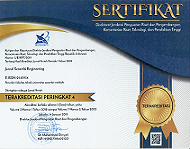Identifikasi dan Analisis Rumah Sehat Berdasarkan Standar Kementerian Kesehatan (Studi Kasus: Gampong Mulia, Kota Banda Aceh)
Keywords:
Settlement, Healthy Housing, Indonesian Ministry of Health Standard, Banda Aceh, Gampong MuliaAbstract
A healthy home is a crucial indicator in establishing liveable settlements and supporting the overall well-being of residents. This study aims to identify and analyse the condition of healthy homes in Gampong Mulia, Kuta Alam Subdistrict, Banda Aceh City, based on indicators established by the Indonesian Ministry of Health. The location was selected due to its dense urban character and its status as a recipient area for post-tsunami housing assistance following the 2004 disaster. Over time, many of these aid houses have been repurposed as rental housing, leading to variations in physical conditions and resident behaviours. A descriptive quantitative method was applied, using field surveys and interviews. Twenty-five sample houses across five village zones were assessed based on three components: physical condition, sanitation facilities, and resident behaviour. The results show that 88% of the houses meet the criteria for healthy homes (total score ≥ 1,068), while 12% fall below the standard, all of which are located in Tgk. Di Leupeu Hamlet—an area with a notable concentration of rental units. The highest average score was for resident behaviour (425), followed by physical condition (534), and sanitation (322). This research highlights the need for targeted interventions, particularly in post-disaster communities, to support sustainable and equitable settlement planning.
References
[1] W. H. Organization, “Housing and Health Guidelines,” Geneva: World Health Organization., 2018.
[2] K. K. R. Indonesia, “Peraturan Menteri Kesehatan Republik Indonesia Nomor 1077/MENKES/PER/V/2011 tentang Pedoman Penyehatan Rumah,” Jakarta, Kementerian Kesehatan RI, 2011.
[3] D. K. RI, “Keputusan Menteri Kesehatan Republik Indonesia Nomor 829/Menkes/SK/VII/1999 tentang Persyaratan Kesehatan Rumah,” Jakarta, Depkes RI, 1999.
[4] E. &. S. D. Wulandari, “Konsep Pengembangan Kota Banda Aceh sebagai Kota Wisata Tsunami,” ARCADE: Jurnal Arsitektur dan Perencanaan, vol. 1, no. 1, p. 1–7, 2017.
[5] Y. F. &. O. R. S. Syamsidik, “Post-disaster housing in Aceh: Re-evaluation and future need,” Journal of Architecture and Urbanism, vol. 43, no. 1, p. 69–80, 2019.
[6] B. P. S. K. B. Aceh, Kecamatan Kuta Alam Dalam Angka, Banda Aceh: Badan Pusat Statistik, 2024.
[7] L. Damanik, “Kualitas Permukiman dan Hubungannya dengan Kesehatan Lingkungan,” Jurnal Perencanaan Wilayah dan Kota, vol. 18, no. 2, p. 55–67, 2021.
[8] P. P. Indonesia, Undang-Undang Republik Indonesia Nomor 1 Tahun 2011 tentang Perumahan dan Kawasan Permukiman., Jakarta: Indonesia, Pemerintah Pusat, 2011.
[9] Y. &. S. N. Setiawan, “Permukiman Layak dan Kesehatan Masyarakat,” Jurnal Perencanaan Pembangunan, vol. 11, no. 1, pp. 1-12, 2020.
[10] B. S. Nasional, SNI 03-6572-2001: Tata Cara Perencanaan Lingkungan Perumahan Sehat, Jakarta: BSN, 2001.
[11] W. H. Organization, Health in the Built Environment: Global Evidence and Recommendations, Geneva: WHO, 2021.
[12] K. &. R. R. Amri, “Dampak Kualitas Rumah Terhadap Kesehatan Penghuni di Permukiman Padat Kota,” Jurnal Kesehatan Lingkungan, vol. 21, no. 1, p. 42–50, 2022.
[13] R. M. D. &. S. A. Riviwanto, Sanitasi dan Rumah Sehat, Yogyakarta: Pustaka Pelajar, 2011.
[14] E. N. M. &. S. S. Susanti, “Hubungan Kondisi Rumah dengan Kesehatan Anak di Lingkungan Kumuh,” Jurnal Promkes, vol. 9, no. 2, p. 105–113, 2021.
[15] A. M. U. S. &. K. A. Khan, “Healthy Housing: A Key Component of Urban Sustainability,” International Journal of Environmental Research and Public Health, vol. 17, no. 4, p. 1034, 2020.
[16] B. W. D. &. S. A. Arifin, “Evaluasi Penerapan Rumah Sehat di DKI Jakarta,” Jurnal Tata Kota, vol. 14, no. 2, p. 98–107, 2023.
[17] N. P. A. N. &. Y. R. Hanifa, “Pengaruh Sanitasi Permukiman Terhadap Kejadian Penyakit Berbasis Lingkungan,” Jurnal Epidemiologi Kesehatan, vol. 10, no. 1, p. 73–82, 2022.
[18] R. &. M. M. Lubis, “Ventilasi dan Risiko ISPA pada Anak di Rumah Padat Penduduk,” Jurnal Kesehatan Komunitas, vol. 9, no. 2, p. 88–95, 2020.
[19] T. I. F. &. A. R. Rahmat, “Validasi Parameter Rumah Sehat di Wilayah Perkotaan Padat.,” Jurnal Ilmu Kesehatan Masyarakat, vol. 10, no. 3, p. 135–144, 2019.
[20] Sugiyono, Metode Penelitian Kuantitatif, Kualitatif, dan R&D., Bandung: Alfabeta, 2019.
[21] N. M. W. T. &. N. B. Sari, “Analisis Hubungan Antara Kondisi Fisik Rumah dan Penyakit Berbasis Lingkungan di Permukiman Padat Penduduk,” Jurnal Kesehatan Masyarakat Nasional, vol. 17, no. 2, p. 123–132, 2022.
[22] K. K. RI, Profil Kesehatan Indoensia Tahun 2019, Jakarta: Kementrian Keseharan RI, 2020.
[23] R. A. &. A. N. Putri, “Perilaku Penghuni Rumah Sehat: Evaluasi PHBS di Lingkungan Padat Kota.,” Jurnal Promosi Kesehatan Indonesia, vol. 16, no. 3, p. 210–218, 2021.
[24] R. W. D. &. U. H. Susanti, “Ketimpangan Akses Rumah Sehat pada Wilayah Urban: Studi Kasus Kota Surabaya.,” Jurnal Ilmu Lingkungan, vol. 18, no. 1, p. 55–66, 2020).
[25] Y. F. &. O. R. S. Syamsidik, “Post-disaster Housing in Aceh: Re-evaluation and Future Needs.,” Journal of Architecture and Urbanism, vol. 43, no. 1, p. 69–80, 2019.
[26] P. Pusat, Undang-undang (UU) Nomor 28 Tahun 2002 tentang Bangunan Gedung, Pemerintah Pusat: Indonesia, Pemerintah Pusat, 2002.
Downloads
Published
Issue
Section
License
Copyright (c) 2025 Sri Batara Nurfajri Arisaputri, Elysa Wulandari, Nini Rahayu Nur, Shabira Salsabila (Author)

This work is licensed under a Creative Commons Attribution 4.0 International License.












